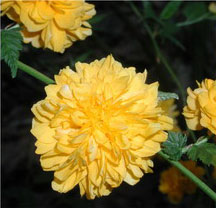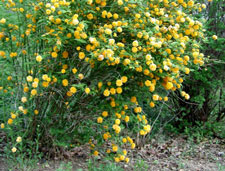Resource Library
Plant of the Week: Yellow Rose of Texas
The University of Arkansas System Division of Agriculture does not promote, support or recommend plants featured in "Plant of the Week." Please consult your local Extension office for plants suitable for your region.
Plant of the Week
Yellow Rose of Texas
Latin: Kerria japonica

Since Dolly made her debut cloning has been much in the news. While cloning is far from the norm in the animal kingdom, it is commonplace amongst plants.
One plant in my garden, Kerria japonica, is a clone that has been handed from gardener to gardener for hundreds, perhaps thousands, of years. My plant is identical to, and a direct descendant of, the one an unnamed Chinese mandarin first collected from the wild for his own garden in far off China.
Kerria, is sometimes called the "Yellow Rose of Texas," though it is neither a rose nor from Texas. It’s a monotypic species native to China belonging to the rose family and most closely associated with brambles and spireas. It grows as a 6-foot tall deciduous, crown-forming shrub with slender erect-growing bright green branches.
Mostly we pay little attention to Kerria except when it’s in bloom mid-spring. The typical form in cultivation is the double-flowered type with orange-yellow blossoms about an inch and a half across. These form perfect powder puffs with upwards to a hundred petals.
Because the plant is sterile it remains in bloom far longer than the single-flowered form that is occasionally offered.
Kerria is named for William Kerr (d. 1814), the first full-time resident plant collector sent out by London’s Kew Garden to collect plants in China. Kerr arrived in South China in 1803, but, because of restrictions imposed by trade agreements with the Chinese, wasn’t allowed to travel further than half a day’s journey from the trading port where he was based. Consequently, most of the plants he collected and sent back to England were purchased from the Fa-Te nursery district near modern day Guangzhou (near Hong Kong).
Kerr sent home many now common garden plants including Nandina, Chinese Juniper, tree peony, evergreen Ligustrum, Gardenia, and a number of others, including the double-flowered Kerria that arrived in 1805. Kerria bears the epitaph "japonica" because one of Linnaeus’ students, Carl Thunberg, first described the plant from material he had collected in Japan in 1776. A French botanist correctly classified the shrub and named it after William Kerr.

Getting living plants from China to Europe was a difficult task and, even if the ships weren’t lost in typhoons or other shipping mishaps, watering and other basic needs were often neglected by captain and crew. To remedy this problem Kerr at least once employed the services of a Chinese gardener to accompany the plants back to England.
Kerr seems to have had too much time on his hands in China, and because he couldn’t go out and explore the hinterland away from the port cities, he fell into some bad habits. Though his contemporaries never come out and say it directly, it appears Kerr became an opium smoker and his work fell off dramatically after the first three or four years in China.
Kerria is easy to propagate by crown division or hardwood cuttings, so it spreads quickly once introduced. Thirty years after its introduction to England it had become commonplace and was "so common to even be found in the gardens of laborers." The single-flowered form was introduced in 1835.
Kerria is an easy to grow plant that will flower even in moderate shade but plants are much more floriferous and vigorous if given full sun conditions. It tolerates poor soil but does best in normal garden loam. Once established it has considerable drought tolerance.
Plants are hardy from zones 4 through 9. It has no serious insect or disease problems, but old canes tend to die after a few years and need to be periodically removed to keep the plant neat and attractive. Heavy pruning should be done when plants finish flowering as needed to control size and spread.
By: Gerald Klingaman, retired
Extension Horticulturist - Ornamentals
Extension News - March 28, 2008
The University of Arkansas System Division of Agriculture does not maintain lists of retail outlets where these plants can be purchased. Please check your local nursery or other retail outlets to ask about the availability of these plants for your growing area.